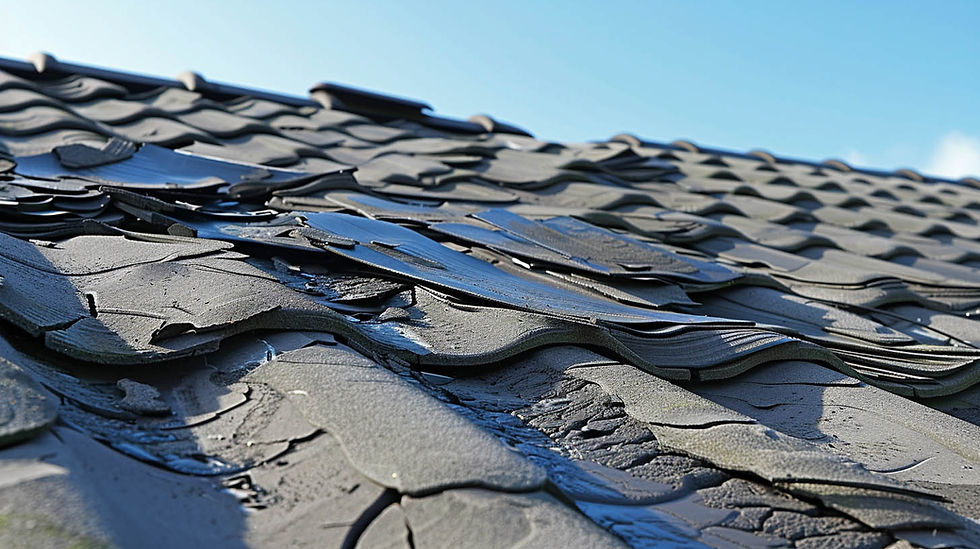Do Quick-Fix Roof Patches Really Solve the Problem?
- Vlad Antoniuk
- Aug 28
- 4 min read
Roof leaks often appear unexpectedly, prompting homeowners to seek quick fixes like roofing tape or cement. While these may seem like easy solutions, they can lead to more significant issues later. The team at East Penn Roofing in Allentown, PA, advises against relying on temporary repairs. Instead, it's best to consult a roofing professional for a permanent solution. If you've attempted to patch your roof yourself, now is the time to seek expert help for lasting protection and safety for your home.
Common Reasons Homeowners Try Quick-Fix Roof Patches
Emergency leaks during storms often catalyze homeowners to seek immediate but temporary roofing solutions. The urgency to prevent further damage can lead to the quick application of roof tape or roofing cement over loose shingles and small holes. In such high-pressure situations, quick fixes like duct tape or Flex Seal seem like a viable option to stave off water damage until a more comprehensive repair can be scheduled with a professional roofer.
Delaying full repairs typically stems from financial constraints or the perception that time is in short supply. For many homeowners, the thought of investing in a new roof or extensive repairs feels daunting.

Emergency Leaks During Storms
Unforeseen weather events can catch homeowners off guard, prompting urgent responses to leaks. Temporary fixes like roofing tape, sealants, or tarps can provide immediate relief during severe storms, covering damaged areas such as loose shingles or seams. This quick action minimizes water damage and prevents issues like rot or mold.
However, these methods are only short-term solutions and shouldn't replace comprehensive repairs. Relying on quick fixes like duct tape or roofing cement without addressing underlying problems can worsen the situation.
Delaying Full Repairs Due to Cost or Time
Cost and time often lead homeowners to postpone comprehensive roof repairs. Quick fixes like roofing tape or cement may seem appealing during emergencies, but they only provide temporary relief from leaks without addressing underlying issues such as loose shingles or compromised flashing.
Professional roofers warn that neglecting full repairs can lead to further damage, including mold growth and deteriorated underlayment. Relying on quick fixes increases the risk of hidden water intrusion, resulting in costly repairs later. Investing in a new roof or thorough repair can ultimately save money and prevent headaches associated with deteriorating roofing systems.

The Limitations of Temporary Roof Patches
Temporary roof patches offer immediate relief from leaks but often provide only short-term solutions. Homeowners frequently choose these quick fixes during emergencies, like storms, without recognizing they merely mask deeper issues. Unchecked water intrusion can lead to deterioration of underlying materials, such as underlayment and plywood, resulting in costly repairs later.
Different roofing types, like metal roofs and asphalt shingles, present unique challenges. Insufficient adhesion from roofing tape or cement can cause recurring leaks, while poor installation may promote mold growth around chimneys and vents. Hiring a professional roofer for evaluation is usually wiser than relying on temporary fixes.
Short-Term Relief vs. Long-Term Damage
Temporary fixes often provide immediate relief from a leaky roof, particularly during unexpected storms. Utilizing roofing tape, roofing cement, or a tarp can halt the water intrusion, allowing homeowners some breathing room. However, these solutions are inherently temporary. While they might patch small holes or address loose shingles, they typically lack the adhesion and durability required for long-term effectiveness.
Over time, neglecting to pursue full repairs can lead to significant structural issues, exacerbating problems like mold growth or extensive water damage. A professional roofer understands that while a quick fix might serve a purpose.

Hidden Risks: Water Intrusion and Mold Growth
Temporary fixes for roof leaks often come with significant hidden risks, particularly concerning water intrusion and mold growth. Quick solutions like roofing tape or roofing cement may provide immediate relief by covering small holes or securing loose shingles, but their effectiveness is generally short-lived. Without proper adhesion and a clean surface, these temporary patches can fail during heavy rains or storms, allowing moisture to seep beneath roofing layers, especially vertical seams or underlayment.
The presence of trapped moisture creates an ideal environment for mold development, leading to further damage within the attic or living space. Homeowners neglecting the underlying issues risk not only their roof's integrity but also potential health hazards due to mold exposure.
In Summary
Homeowners often seek quick-fix solutions for roofing repairs, such as roofing tape or cement. While tempting, these temporary patches provide only momentary relief from leaks and can mask deeper issues like loose shingles or poor adhesion.
Recognizing the limitations of these methods is vital. Quick fixes rarely tackle root causes, like deteriorated underlayment or compromised flashing around chimneys and vents. A comprehensive evaluation by a professional roofer is essential to maintain roof integrity and avoid costly future repairs. Ultimately, investing in long-term solutions protects your roof and safeguards your home.
Frequently Asked Questions
What is the best thing to cover a leaking roof?
To cover a leaky roof for a short time, homeowners can use things like a tarp, flex seal, roofing tape, or roofing cement. First, make sure the damaged part is clean before you put any patch on it. These quick fixes are good if you are in a pinch, but it is best to call a professional roofer to help you get a long-term solution for your leaky roof.
Does roof treatment really work?
The effectiveness of roof treatments can vary widely. While they may offer temporary relief, they often fall short in addressing underlying issues. For lasting solutions, comprehensive inspections and repairs are essential to prevent further damage and ensure the long-term integrity of your roof.
Read our blog: What to Expect During a Professional Roofing Inspection




Comments